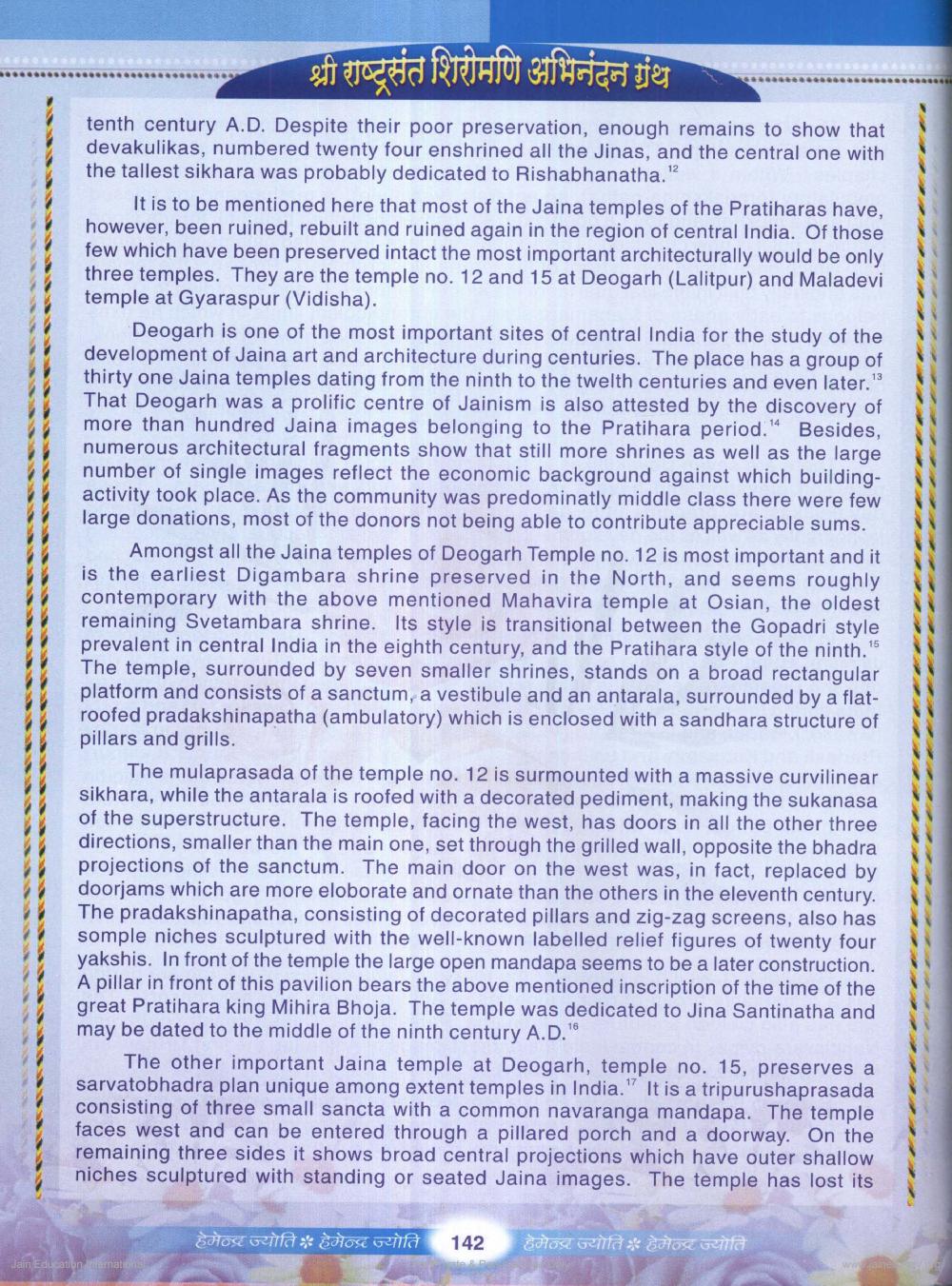________________
श्री राष्ट्रसंत शिरोमणि अभिनंदन ग्रंथ
A
tenth century A.D. Despite their poor preservation, enough remains to show that devakulikas, numbered twenty four enshrined all the Jinas, and the central one with the tallest sikhara was probably dedicated to Rishabhanatha."
It is to be mentioned here that most of the Jaina temples of the Pratiharas have, however, been ruined, rebuilt and ruined again in the region of central India. Of those few which have been preserved intact the most important architecturally would be only three temples. They are the temple no. 12 and 15 at Deogarh (Lalitpur) and Maladevi temple at Gyaraspur (Vidisha).
Deogarh is one of the most important sites of central India for the study of the development of Jaina art and architecture during centuries. The place has a group of thirty one Jaina temples dating from the ninth to the twelth centuries and even later." That Deogarh was a prolific centre of Jainism is also attested by the discovery of more than hundred Jaina images belonging to the Pratihara period. Besides, numerous architectural fragments show that still more shrines as well as the large number of single images reflect the economic background against which buildingactivity took place. As the community was predominatly middle class there were few large donations, most of the donors not being able to contribute appreciable sums.
Amongst all the Jaina temples of Deogarh Temple no. 12 is most important and it is the earliest Digambara shrine preserved in the North, and seems roughly contemporary with the above mentioned Mahavira temple at Osian, the oldest remaining Svetambara shrine. Its style is transitional between the Gopadri style prevalent in central India in the eighth century, and the Pratihara style of the ninth." The temple, surrounded by seven smaller shrines, stands on a broad rectangular platform and consists of a sanctum, a vestibule and an antarala, surrounded by a flatroofed pradakshinapatha (ambulatory) which is enclosed with a sandhara structure of pillars and grills.
The mulaprasada of the temple no. 12 is surmounted with a massive curvilinear sikhara, while the antarala is roofed with a decorated pediment, making the sukanasa of the superstructure. The temple, facing the west, has doors in all the other three directions, smaller than the main one, set through the grilled wall, opposite the bhadra projections of the sanctum. The main door on the west was, in fact, replaced by doorjams which are more eloborate and ornate than the others in the eleventh century. The pradakshinapatha, consisting of decorated pillars and zig-zag screens, also has somple niches sculptured with the well-known labelled relief figures of twenty four yakshis. In front of the temple the large open mandapa seems to be a later construction. A pillar in front of this pavilion bears the above mentioned inscription of the time of the great Pratihara king Mihira Bhoja. The temple was dedicated to Jina Santinatha and may be dated to the middle of the ninth century A.D.
The other important Jaina temple at Deogarh, temple no. 15, preserves a sarvatobhadra plan unique among extent temples in India." It is a tripurushaprasada consisting of three small sancta with a common navaranga mandapa. The temple faces west and can be entered through a pillared porch and a doorway. On the remaining three sides it shows broad central projections which have outer shallow niches sculptured with standing or seated Jaina images. The temple has lost its
ENOTE gia * Sitose vifa
142
हेमेन्य ज्योति* हेमेन्द्र ज्योति
Jain Education
nations




